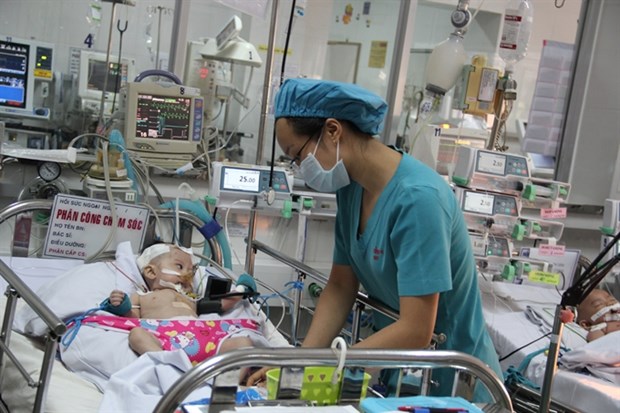Gap remains in hospital quality: experts
A pilot programme on national hospital quality assessment has resulted in positive results, but a gap between policy objectives and operations still exists, hospital officials have said.
 A doctor takes care of a baby in HCM City-based Children Hospital No 1 (Source: VNA)
A doctor takes care of a baby in HCM City-based Children Hospital No 1 (Source: VNA) "The Ministry of Health’s 83 criteria on quality have been applied at all hospitals, but more effort is needed," Luong Ngoc Khue, Director of Medical Services Administration, said at the third National Hospital Quality Forum that wrapped up in HCM City on September 13.
The quality assessment results will be publicised to motivate hospitals to improve quality.
Despite improvements, a number of hospitals, however, still do not recognise the role of quality improvement and have not changed their minds on the role of patients and health workers, according to Khue.
Tang Chi Thuong, Deputy Director of HCM City’s Department of Health, said that treatment incidents still occurred, causing dissatisfaction among patients.
He said patients and families could call the Health Department’s hotlines to report complaints about behaviour or treatment by hospital staff.
Hospitals are still not paying sufficient attention to the management of compliance with treatment protocols and prescriptions, according to Thuong.
The application of IT in administrative procedures has not been done consistently, and the hospital environment is not always safe and secure for patients and health workers.
He attributed the quality of health services to overcrowding and facilities that have not kept pace with the development of professional techniques in hospitals.
To improve medical exam and treatment capacity, the department has piloted several models, including emergency networks, an inter-hospital code blue process, and hemodialysis at commune health stations and satellite departments of the city’s hospitals and district-level hospitals.
The Ministry of Health’s quality assessment criteria is an important legal basis for hospital quality improvement to reduce complaints and patient dissatisfaction.
The department’s health service quality management council has set five objectives: safer, better, faster, cheaper and more satisfied.
Results of Rapid Assessment goals
Jose Cardona, EU Health Facility director, said there was a gap between the national Quality Management and Quality Improvement (QM/QI) policies and the outcomes reflected in daily operations.
Predominant use of the national Quality Management Criteria is focused on scoring and not on the elimination of essential deficits, according to results of a Rapid Check conducted by experts at 13 health facilities.
Of the 13 facilities that have implemented the QM/QI policies, three hospitals said that it was difficult to measure many of the quality management criteria.
Because of training deficits, most of the strategies, priorities or activities are more or less theoretical documents.
In addition, hospitals have been constrained by the difficult mix of in-patients, out-patients and many family members.
Patient identification, quality of care and control of patient falls are also part of QM/QI policies at most hospitals.
Many care activities must be done by relatives such as patient transport, feeding, washing and moving in and out of bed.
Patient falls are focused only on floors and not on other situations such as transport, falls from beds, and patient monitoring in difficult situations.
Besides these issues, medication was found not to be stored or controlled well.
Hand hygiene, which is emphasised in QM policies, has not been implemented well, according to the assessment.
Waste management concepts and fire safety are also not being managed properly under QM/QI.
Four of the hospitals said that that specific training in QM/QI as well as in management was not available. Three hospitals said they did not know how to integrate QM/QI into management policies.
The Rapid Check, which was conducted by one expert over a three to four hour period on average per facility, showed deficits and risks in general and the main needs for improvement.
A limited number of modified criteria were used for the Rapid Assessment, with main focus on implementation of quality/safety, patient care, hygiene, medication, infrastructure, fire safety and staff safety.
Cardona said that specific training regarding QM/QI and its systems and tools as well as modern hospital management training should be conducted, and that the national quality criteria must be updated and clarified.
At the two-day forum, the national Medical Services Administration, in collaboration with the European Union Health Facility, distributed a manual on good practices in quality management to all 500 forum participants.-VNA













